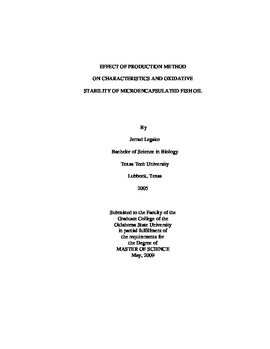| dc.contributor.advisor | Dunford, Nurhan T. | |
| dc.contributor.author | Legako, Jerrad | |
| dc.date.accessioned | 2014-04-15T20:12:55Z | |
| dc.date.available | 2014-04-15T20:12:55Z | |
| dc.date.issued | 2009-05-01 | |
| dc.identifier.uri | https://hdl.handle.net/11244/8837 | |
| dc.description.abstract | The main objective of this study is to evaluate the effect of fish oil microencapsulation method on characteristics and oxidative stability. Four methods, freeze drying, spray drying by a 2 fluid pressure nozzle, spray drying by a 3 fluid pressure nozzle, and spray drying by a 2 channel ultrasonic nozzle were used in this research. Surface morphology of the microcapsules where determined by scanning electron microscopy. Total oil of the microcapsules was determined by soxtec and Rose-Gottlieb solvent extraction methods. Solvent extractable surface oil was also determined. Size of the microcapsules was determined by particle size analysis. Moisture content of the microcapsules was determined by Karl Fischer titration. Oxidative stability of the microcapules was determined over a 15 week period in which HS-SPME was used to analyze volatile oxidative compounds by GC-MS. Comparison of chemical and physical characteristics revealed some differences. With regard to uniformity of size and shape, microcapsules produced by the2-channel ultrasonic nozzle were observed to be more uniform in size and shape, determined by particle size distribution and SEM image comparisons. Disadvantages were also observed for ultrasonic nozzle microcapsules having lower oil encapsulating efficiency compared to pressure nozzles and freeze dried microcapsules. There was no observed initial advantage to spray methods that did not require the creation of an emulsion for microcapsule production. However, it was observed that microcapsules produced by multi-fluid nozzles propanal levels were lower throughout the course of a 14 week stability test. It should be stated that the 15 week sampling period may not have been long enough to adequately observe the induction of oxidation for all samples stored in the conditions chosen. Sample values fluctuated within a moderate range throughout the entire study. However, byobserving propanal levels at the last data point of the stability study some conclusions may be drawn. At the end of the 5 �C test PAR levels for fish oil and freeze dried samples were observed to have a significant increase while spray dried samples values remained steady. This may indicate the beginning of oxidation among the fish oil and freeze dried samples while spray dried samples were remaining stable. | |
| dc.format | application/pdf | |
| dc.language | en_US | |
| dc.publisher | Oklahoma State University | |
| dc.rights | Copyright is held by the author who has granted the Oklahoma State University Library the non-exclusive right to share this material in its institutional repository. Contact Digital Library Services at lib-dls@okstate.edu or 405-744-9161 for the permission policy on the use, reproduction or distribution of this material. | |
| dc.title | Effect of Production Method on Characteristics and Oxidative Stability of Microencapsulated Fish Oil | |
| dc.type | text | |
| dc.contributor.committeeMember | Maness, Niels | |
| dc.contributor.committeeMember | Dewitt, Christina | |
| osu.filename | Legako_okstate_0664M_10186.pdf | |
| osu.college | Agricultural Sciences and Natural Resources | |
| osu.accesstype | Open Access | |
| dc.description.department | Department of Animal Science | |
| dc.type.genre | Thesis | |
